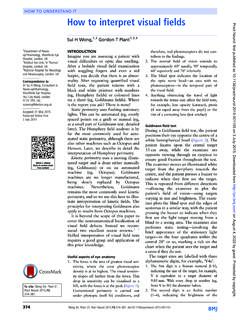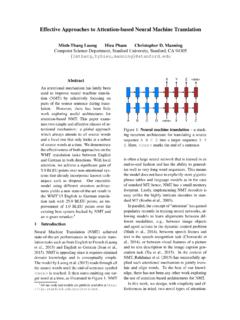Transcription of Gorillas in our midst: sustained inattentional blindness ...
1 Perception, 1999, volume 28, pages 1059 ^ 1074. Gorillas in our midst: sustained inattentional blindness for dynamic events Daniel J Simons, Christopher F Chabris Department of Psychology, Harvard University, 33 Kirkland Street, Cambridge, MA 02138, USA;. e-mail: Received 9 May 1999, in revised form 20 June 1999. Abstract. With each eye fixation, we experience a richly detailed visual world. Yet recent work on visual integration and change direction reveals that we are surprisingly unaware of the details of our environment from one view to the next: we often do not detect large changes to objects and scenes (`change blindness '). Furthermore, without attention , we may not even perceive objects (` inattentional blindness ').
2 Taken together, these findings suggest that we perceive and remember only those objects and details that receive focused attention . In this paper, we briefly review and discuss evidence for these cognitive forms of ` blindness '. We then present a new study that builds on classic studies of divided visual attention to examine inattentional blindness for complex objects and events in dynamic scenes. Our results suggest that the likelihood of noticing an unexpected object depends on the similarity of that object to other objects in the display and on how difficult the priming monitoring task is. Interestingly, spatial proximity of the critical unattended object to attended locations does not appear to affect detection, suggesting that observers attend to objects and events, not spatial positions.
3 We discuss the implications of these results for visual representations and awareness of our visual environment. 1 Introduction ``It is a well-known phenomenon that we do not notice anything happening in our surround- ings while being absorbed in the inspection of something; focusing our attention on a certain object may happen to such an extent that we cannot perceive other objects placed in the peripheral parts of our visual field, although the light rays they emit arrive completely at the visual sphere of the cerebral cortex.''. Rezso Ba lint 1907 (translated in Husain and Stein 1988, page 91). Perhaps you have had the following experience: you are searching for an open seat in a crowded movie theater.
4 After scanning for several minutes, you eventually spot one and sit down. The next day, your friends ask why you ignored them at the theater. They were waving at you, and you looked right at them but did not see them. Just as we sometimes overlook our friends in a crowded room, we occasionally fail to notice changes to the appearance of those around us. We have all had the embarrassing experience of failing to notice when a friend or colleague shaves off a beard, gets a haircut, or starts wearing contact lenses. We feel that we perceive and remember everything around us, and we take the occasional blindness to visual details to be an unusual exception. The richness of our visual experience leads us to believe that our visual representations will include and preserve the same amount of detail (Levin et al 2000).
5 The disparity between the richness of our experience and the details of our repre- sentation, though `well known' to Ba lint in 1907, has been studied only sporadically in the psychological literature since then, and many of the most striking results appear to have been neglected by contemporary researchers. Although the past 20 years have seen increasing interest in the issue of the precision of visual representations, a series of studies from the 1970s and 1980s using dynamic visual displays provides some of the most dramatic demonstrations of the importance of attention in perception (see Neisser 1979 for an overview). In these studies, observers engage in a continuous task that requires them to focus on one aspect of a dynamic scene while ignoring others.
6 1060 D J Simons, C F Chabris At some point during the task an unexpected event occurs, but the majority of observers do not report seeing it even though it is clearly visible to observers not engaged in the concurrent task (Becklen and Cervone 1983; Littman and Becklen 1976; Neisser 1979;. Neisser and Becklen 1975; Rooney et al 1981; Stoffregen et al 1993; Stoffregen and Becklen 1989). Although these studies have profound implications for our understand- ing of perception with and without attention , and despite their obvious connection to more recent work on visual attention (eg change blindness , attentional blink, repetition blindness , inattentional blindness ), the empirical approach has fallen into disuse.
7 One goal of our research is to revive the approach used in these original studies of `selective looking' in the context of more recent work on visual attention . Over the past few years, several researchers have demonstrated that conscious per- ception seems to require attention . When attention is diverted to another object or task, observers often fail to perceive an unexpected object, even if it appears at fixation . a phenomenon termed ` inattentional blindness ' (eg Mack and Rock 1998).(1) These findings are reminiscent of another set of findings falling under the rubric of `change blindness '. Observers often fail to notice large changes to objects or scenes from one view to the next, particularly if those objects are not the center of interest in the scene (Rensink et al 1997).
8 For example, observers often do not notice when two people in a photograph exchange heads, provided that the change occurs during an eye movement (Grimes 1996; see Simons and Levin 1997 for a review). Such studies suggest that attention is necessary for change detection (see also Scholl 2000), but not sufficient, as even changes to attended objects are often not noticed (Levin and Simons 1997;. Simons and Levin 1997, 1998; Williams and Simons 2000). For example, observers who were giving directions to an experimenter often did not notice that the experimenter was replaced by a different person during an interruption caused by a door being carried between them (Simons and Levin 1998). Both areas of research focus on two fundamental questions.
9 (i) To what degree are the details of our visual world perceived and represented? (ii) What role does attention play in this process? We will review recent evidence for inattentional blindness to provide a current context for a discussion of earlier research on the perception of unexpected events. We then present a new study examining the variables that affect inattentional blindness in naturalistic, dynamic events, and consider the results within the broader framework or recent attention research, including change blindness . inattentional blindness Studies of change blindness assume that, with attention , features can be encoded (abstractly or otherwise) and retained in memory. That is, all of the information in the visual environment is potentially available for attentive processing.
10 Yet, without atten- tion, not much of this information is retained across views. Studies of inattentional blindness have made an even stronger claim: that, without attention , visual features of our environment are not perceived at all (or at least not consciously perceived) . observers may fail not just at change detection, but at perception as well. Recent work on the role of attention in perception has explored what happens to unattended parts of simple visual displays (Mack and Rock 1998; Mack et al 1992;. Moore and Egeth 1997; Newby and Rock 1998; Rock et al 1992; Rubin and Hua 1998;. Silverman and Mack 1997). In traditional models of visual search, features are often assumed to be processed preattentively if search speeds are unaffected by the number (1) Mack and Rock (1998) draw a distinction between conscious perception and implicit perception.




![arXiv:2108.00154v2 [cs.CV] 8 Oct 2021](/cache/preview/5/1/4/3/3/e/9/d/thumb-51433e9dee8472b1576151350bb9b5bc.jpg)



